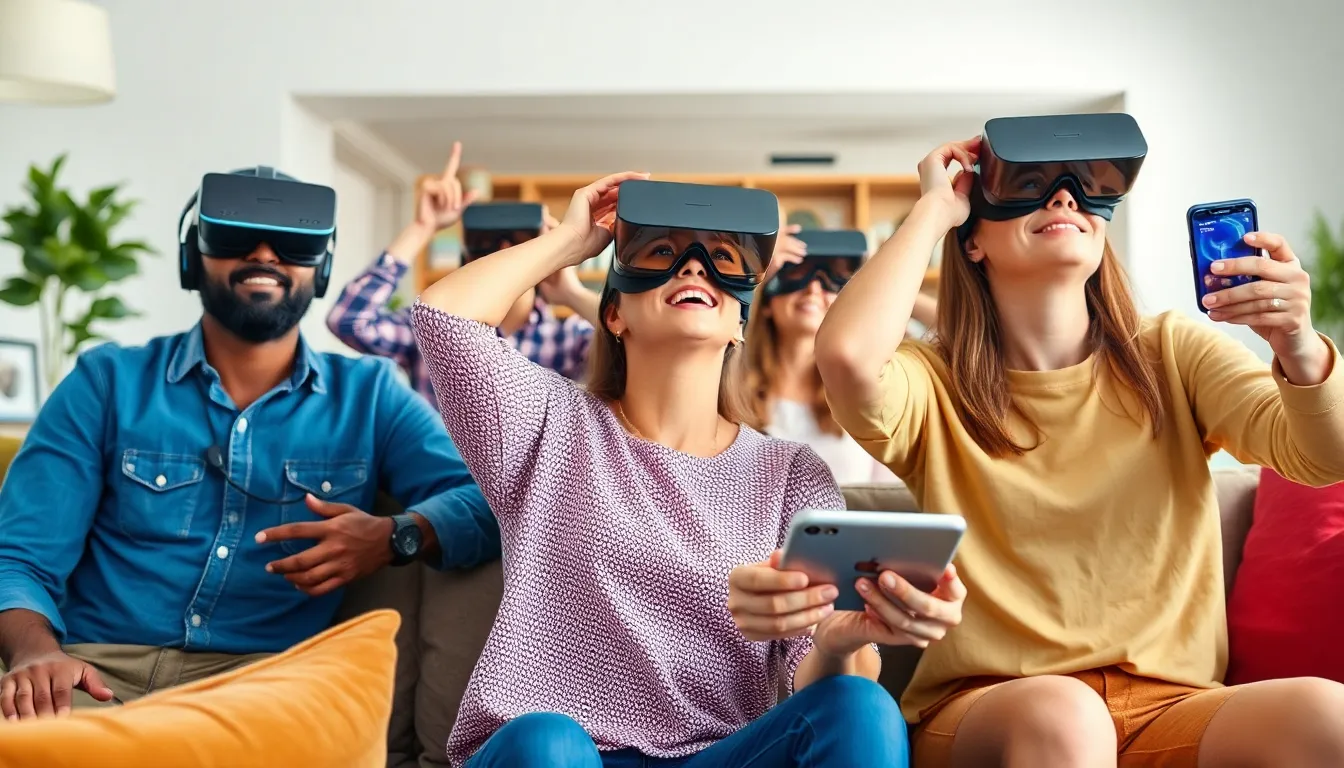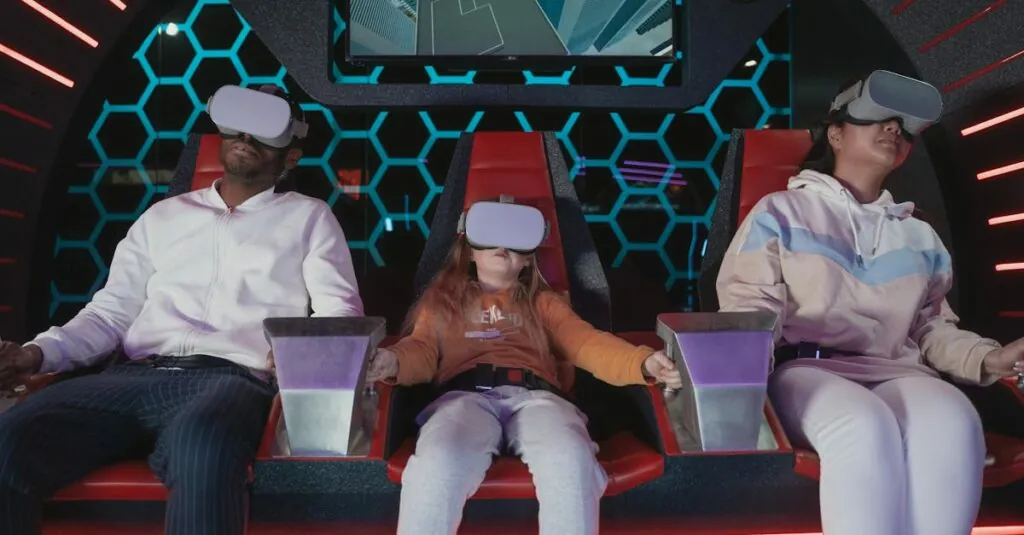Virtual reality headsets are the latest gadgets that’ll make anyone feel like they’ve stepped straight into a sci-fi movie. Gone are the days of simply watching videos or playing games on a screen; now, users can immerse themselves in fantastical worlds where they can dodge virtual dragons or explore the depths of the ocean—all from the comfort of their living room.
Table of Contents
ToggleOverview of VR Headsets
Virtual reality headsets represent a remarkable technological advancement, offering users visceral experiences that transport them beyond the limits of reality. These devices integrate advanced display technology with sensors, allowing for both visual immersion and motion tracking.
Types of VR headsets vary widely. Standalone headsets operate independently without a separate computer, providing convenience and mobility. PC-connected headsets deliver higher graphical fidelity, utilizing powerful GPUs for an enhanced experience. Mobile VR headsets rely on smartphones as the display and processing unit, offering accessibility on a budget.
Key features influence user experience. Higher resolution enhances clarity, while wider fields of view create a more encompassing environment. Integrated audio systems amplify immersion by providing realistic soundscapes, crucial for engaging gameplay or narrative experiences.
Popular VR headsets include the Oculus Quest 2, known for its versatility and user-friendly interface, and the Valve Index, which boasts high refresh rates and precision tracking. Both options cater to different user preferences, demonstrating the range available in the market.
Usage scenarios extend beyond gaming. Many individuals utilize VR headsets for training simulations in fields like medicine, where realistic practice scenarios contribute to skill development. Educational programs leverage VR to create interactive learning environments that captivate students and enhance retention.
Market trends underscore the expanding adoption of virtual reality. A report from IDC highlighted that the global VR headset market is set to grow significantly, reaching over $2 billion by 2024. This surge indicates a strong interest in immersive technology across various sectors, suggesting a bright future for VR innovations.
Types of VR Headsets

Various types of VR headsets cater to different user needs and preferences. These include standalone, tethered, and mobile options.
Standalone VR Headsets
Standalone VR headsets operate independently without external devices. Built-in processing power and storage allow users to enjoy immersive experiences directly from the headset. Popular models, such as the Oculus Quest 2, provide a wireless experience with high-resolution displays. Users appreciate the convenience of easy setup, making standalone headsets ideal for beginners and casual gamers. With advancements in technology, these devices feature integrated audio systems for an enhanced experience. Standalone models also provide access to a wide range of applications, including games and virtual social platforms.
Tethered VR Headsets
Tethered VR headsets connect to gaming PCs or consoles to deliver superior graphics and performance. Higher-end models, like the Valve Index, require a physical connection to a computer, which enhances the overall experience with more detailed environments. These headsets often feature advanced sensors and tracking technology for precise movement capture. Users value the expansive gaming libraries available on PC platforms, providing access to numerous titles with rich graphics. Tethered models suit serious gamers seeking the most immersive and realistic experiences within virtual spaces.
Mobile VR Headsets
Mobile VR headsets utilize smartphones to create a virtual experience, offering a budget-friendly entry point. Devices such as the Samsung Gear VR and Google Cardboard require users to insert their smartphones to access VR content. Portability stands out as a significant advantage, enabling users to carry and use these headsets easily. Although mobile VR typically has lower graphical fidelity compared to standalone or tethered models, it supports a variety of applications, including guides and simple games. Users appreciate the accessibility of mobile VR, making it an attractive option for exposure to virtual reality.
Key Features to Consider
When selecting a VR headset, several features greatly impact the overall experience. Users must evaluate these aspects to find the ideal device.
Display Quality
Display quality significantly influences immersion levels. Higher resolution offers clearer images, reducing the screen-door effect that disrupts clarity. Modern headsets often feature resolutions from 1080p to over 2000p per eye. Colors should also appear vibrant, achieving accurate reproduction. Refresh rates of 90Hz or higher minimize motion blur, enhancing smooth visuals during fast-paced action. Invest time in researching models to determine which displays meet personal preferences.
Field of View
Field of view defines how much users can see in the virtual environment. Headsets typically range from 90 to 110 degrees. Wider fields of view enhance the feeling of presence, allowing users to engage more naturally with surroundings. Users should look for models that provide an expansive view without significant distortions. A larger field of view enhances overall immersion, thus optimizing the VR experience.
Tracking and Controllers
Tracking technology directly affects movement accuracy within the virtual space. Most headsets utilize inside-out tracking, eliminating external sensors and simplifying setup. High-quality systems track movements at a precision level, allowing natural user interactions. Controllers must also offer ergonomic designs and responsive feedback, enhancing the experience. Advanced models incorporate hand tracking, providing additional options for interaction and gameplay. Choosing headsets with robust tracking capabilities leads to a more satisfying experience.
Popular VR Headsets on the Market
Several VR headsets lead the market today, each providing unique experiences tailored to different user preferences.
Oculus Quest 2
Oculus Quest 2 stands out as an accessible all-in-one headset. Users appreciate its impressive resolution of 1832 x 1920 per eye, paired with a 90 Hz refresh rate. This device supports a wide range of games and applications without requiring a gaming PC. Weighing less than previous models, Quest 2 enhances comfort during use. The intuitive touch controllers add to the realistic interaction quality, making it popular among casual and serious gamers alike.
HTC Vive Pro 2
HTC Vive Pro 2 offers a premium VR experience with stunning graphics. It features a resolution of 2448 x 2448 per eye and a 120 Hz refresh rate. Performance stands out when connected to a powerful PC, ensuring immersive gameplay. Audiophiles value the high-fidelity audio delivered through integrated spatial sound technology. Users can also enjoy modular face pads and adjustable head straps for increased comfort during extended sessions.
PlayStation VR2
PlayStation VR2 serves as an upgrade for PlayStation 5 users looking for an immersive experience. It boasts a resolution of 2000 x 2040 per eye and a 110-degree field of view. Enhanced haptic feedback and adaptive triggers on the controllers deliver a unique tactile sensation. This device integrates seamlessly with PS5 and supports 4K HDR content for richer visuals. Users can also explore a growing library of exclusive games designed to maximize the platform’s capabilities.
The rise of VR headsets has transformed the way users engage with digital content. With advancements in technology and a growing market, these devices are not just for gaming but also serve educational and professional purposes.
As the industry evolves, more options become available catering to various preferences and budgets. Whether it’s a standalone headset for casual use or a high-end tethered model for serious gamers, there’s something for everyone.
The future of VR looks bright, with innovations on the horizon promising even more immersive experiences. Embracing this technology now positions users to explore limitless possibilities in virtual environments.





